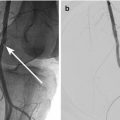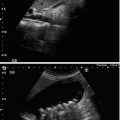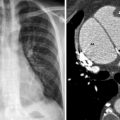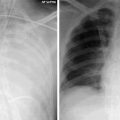Fig. 12.1
Commonly used radiographic contrast agents
X-Ray Positive: Barium and Iodine-Containing Agents
The use of barium sulfate is restricted to opacification of the gastro-intestinal tract for fluoroscopic examinations. Particularly when used in combination with a negative contrast agent (double contrast) it can give exquisite mucosal detail.
A suspension of barium sulfate particles with water, thickener and declumping agents is swallowed, given via a naso-gastric tube or administered as an enema. Due to the fact that barium is insoluble in water it cannot be absorbed or metabolized and must be eliminated with feces. Barium sulfate is contraindicated in cases of suspected perforation. Leakage out of the gastrointestinal lumen can cause severe inflammatory reactions and necrosis of surrounding tissues.
In clinical practice barium sulfate has been almost completely replaced by water- or fat-soluble iodine based agents.
Iodinated contrast media are usually classified as
Ionic – due to higher osmolality these have more side effects and can lead to a higher frequency of contrast induced nephropathy and local phlebitis;
Nonionic – have lower osmolality and tend to be less toxic as they don’t dissociate into charged molecules.
Both types of iodinated contrast agents are primarily used intravenously but can equally be administered via intraarterial, intrathecal, intravesical, oral or rectal access. They are mainly intended to visualize vascular trees but can also be used to enhance imaging of the urinary and intestinal tract or the uterus and fallopian tubes.
In the advent of high resolution CT and MRI the use of gasses such as air, CO2 or Xenon as negative contrast agents has mostly been superseded.
Adverse Effects
The iodinated contrast agents in use today are mostly well tolerated. However, anaphylactoid reactions and contrast-induced nephropathy remain of concern, particularly in critically ill patients. The incidence of adverse events occurring after intravenous administration of contrast has dramatically decreased since switching from ionic high-osmolality (HOCM) to nonionic low-osmolality contrast media (LOCM).
Generally, adverse effects are mild and only require observation and reassurance. Supportive measures may become necessary occasionally. Severe, life-threatening reactions still occur randomly. It is important to note that the majority of severe adverse effects happen in the first 20 min after contrast administration.
HOCM generate acute adverse events in 5–15 % of all patients. The use of LOCM is associated with an incidence of 0.2–0.7 % of adverse events. Serious acute reactions are very rare and occur after 0.01–0.02 % of intravascular injections.
Table 12.1 gives an overview of conditions associated with an increased rate of acute adverse reactions to contrast. Premedicating patients with these conditions with steroids and/or a H1 receptor blocker might help decreasing the incidence even further although data is limited.
Table 12.1
Conditions associated with an increased incidence of acute adverse contrast reactions
Previous reaction to contrast |
Asthma |
Known food or drug allergies, hayfever |
Advanced age |
Table 12.2 provides a summary of the categories of reactions to contrast media.
Table 12.2
Categories acute adverse contrast reactions
Mild | Nausea | Altered taste | Sweats |
Vomiting | Itching | Rash | |
Cough | Pallor | Hives | |
Warmth | Flushing | Nasal stuffiness | |
Headache | Chills | Facial swelling | |
Dizziness | Shaking | Anxiety | |
Moderate | Tachycardia | Dyspnea | |
Bradycardia | Bronchospasm | ||
Hypertension | Laryngeal edema | ||
Diffuse erythema | Mild hypotension | ||
Severe | Unresponsiveness | Convulsions | |
Cardiorespiratory collapse | Profound hypotension | ||
Arrhythmias | Rapidly progressing laryngeal edema | ||
Anaphylactic Reactions
Anaphylactic reactions are potentially life threatening severe reactions, which occur within minutes after the administration of contrast. These anaphylactic reactions are caused by an IgE- mediated Type I immune response (immediate hypersensitivity) through an antigen-antibody reaction. As little as 1 ml of contrast can lead to an anaphylactic reaction resulting in acute bronchospasm, hypotension and severe urticaria. The principles of treating anaphylactic reactions are the stabilization of the patient’s airway and cardiac function following the advanced life support algorithm.
Stay updated, free articles. Join our Telegram channel

Full access? Get Clinical Tree








